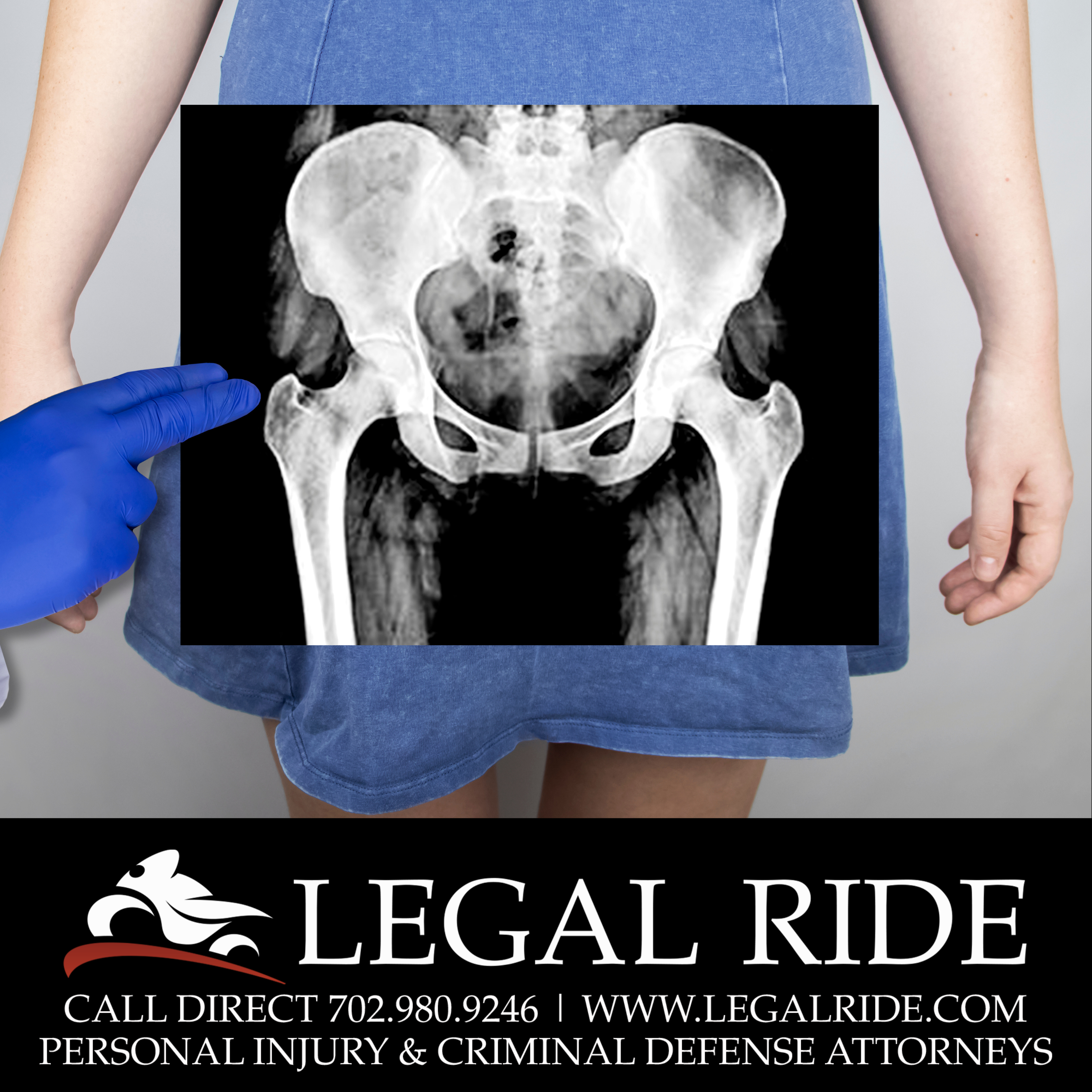Another injury topic very pertinent to motorcycle riders is pelvic injuries. The pelvis is the strongest and most protected structure in the body. It takes a lot of energy to damage the pelvis, and many times, pelvic injury is accompanied by a lot of other injuries. There is one doctor in town that testifies that a pelvic injury is, by definition, also a spine injury. I don’t fully agree, but appreciate the sentiment, for the reasons explained below.
The pelvis is made of three big parts. The two sides and the middle part. The sides are made up of three parts each. The top parts are called Ilium, and the lower part is the Pubis and the Ischium. There are two of those sets of bones, one on the right and one on the left, and they are connected on the top to the Sacrum, or what most people call the tail bone. The Ilium is connected at the bottom by the Symphysis Pubis. When you feel your hip, that is the Ilium and is called the Iliac Crest. The butt bone, what you feel in the bottom of your butt, is the Ischium. A couple of anatomical diagrams are included for reference.
Think of the pelvis as a ring, and we can get injuries anywhere around that ring. Common injuries are a separation of the Ilium from the Sacrum on one or both sides. In that case, the repair is to run screws through the Ilium straight into the Sacrum and internally fixate those two bones, thereby losing the motion in that joint. There is a picture of this below. Another common injury is a fracture of the Ilium, which may or may not require surgery. Usually, an Ilium repair, if necessary, consists of a plate and screws to hold the broken parts together.
Another really common, and deadly, injury is what is called an Open Book Fracture. This is the killer pelvic injury. Imagine taking a hard-bound book and opening it up so far that the binding breaks. That is the same thing that can happen in the pelvis. Basically the two Ilium separate at the bottom where they are connected, and then one of the Ilium breaks at the top, at the SI joint, or somewhere lower. Complications of this type of fracture include damage to the nearby femoral artery or other vascular structures leading to internal bleeding. Other complications include nerve damage, abdominal damage, bladder damage, and genital injuries. Another common injury associated with pelvic injuries is femoral or hip injuries, the femoral head, or the proximate end of the femur can break off, and/or the pelvic side of the hip joint can be damaged. Frequently, the femur is broken by the same heavy forces that broke the pelvis, very commonly.
There are several classifications of pelvic injuries that include the “direction” of the injury and more importantly, whether it is stable or unstable. All of the classifications are not really important for the scope of this blog. Suffice to say, unstable fractures carry a high risk of death, due to the associated vascular injuries talked about above. The repair of an open book fracture is highly unique to each person, depending on the location of the fracture and associated complications. Repairs can be internal plates and screws, or if serious enough, might require an external fixator, or a cage around the pelvis on the outside of the body, with pins or rods bolted to the cage and running inside the body to the pelvis to hold the various parts in place. One of the pictures in the “Ball Injury” post included an external fixator to repair an open book fracture suffered by the rider. There are other pictures of this attached below.
The “spine injury by definition” comment above, has to do with the fact that the sacrum is part of the Pelvis as well as being the bottom of the spine. The energy that it took to damage the pelvis can many times damage the adjacent disc or discs in the spine, the lower lumbar discs, L4-5 or L5-S1 (the topic of another post later). Those injuries may not be apparent for many months after an accident, especially if a rider is not able to stand or walk or be weight-bearing for weeks or months following a pelvic injury. Only when they are weight bearing again do they discover the spine damage. So lower lumbar spine injury is frequently associated with pelvic injuries, and also, injury to the SI joint would technically be a spinal injury as much as a pelvic injury, according to some doctors.
We have seen defense doctors argue things like “spontaneous” fractures to try to assist the defense in avoiding responsibility for these serious injuries. Having a thorough knowledge of medicine is critical to winning these cases in trial and obtaining compensation for our clients. Effective cross-examination of medical experts is a crucial skill for motorcycle accident injury attorneys. All of the injury lawyers are Legal Ride Personal Injury & Criminal Defense Attorneys Nevada have spent decades learning the medicine and working with our own experts and doctors to prepare effective cross-examinations of the defense doctors.
As far as protective gear for pelvic injuries, there isn’t much that can absorb the high energy forces required to cause pelvic injuries. Padded riding pants are not going to absorb these sorts of energies. Airbag systems that extend to the lower spine or hips are not proven on the street at this stage of their development and have not found their way onto the streets in very big numbers due to the expense, inconvenience, and complications associated with the systems. So basically, we are left to ride unprotected in regards to this particular body part.
